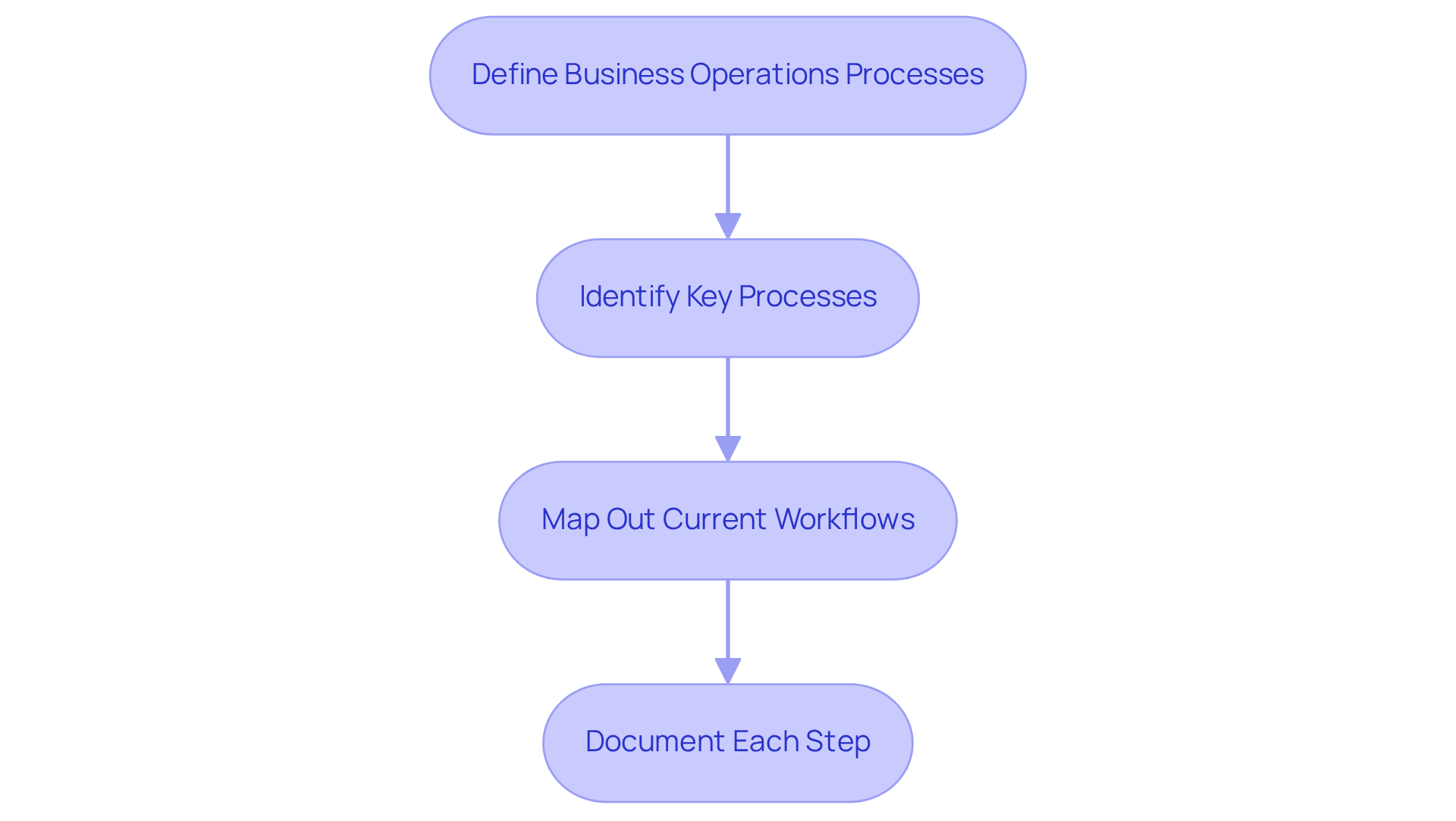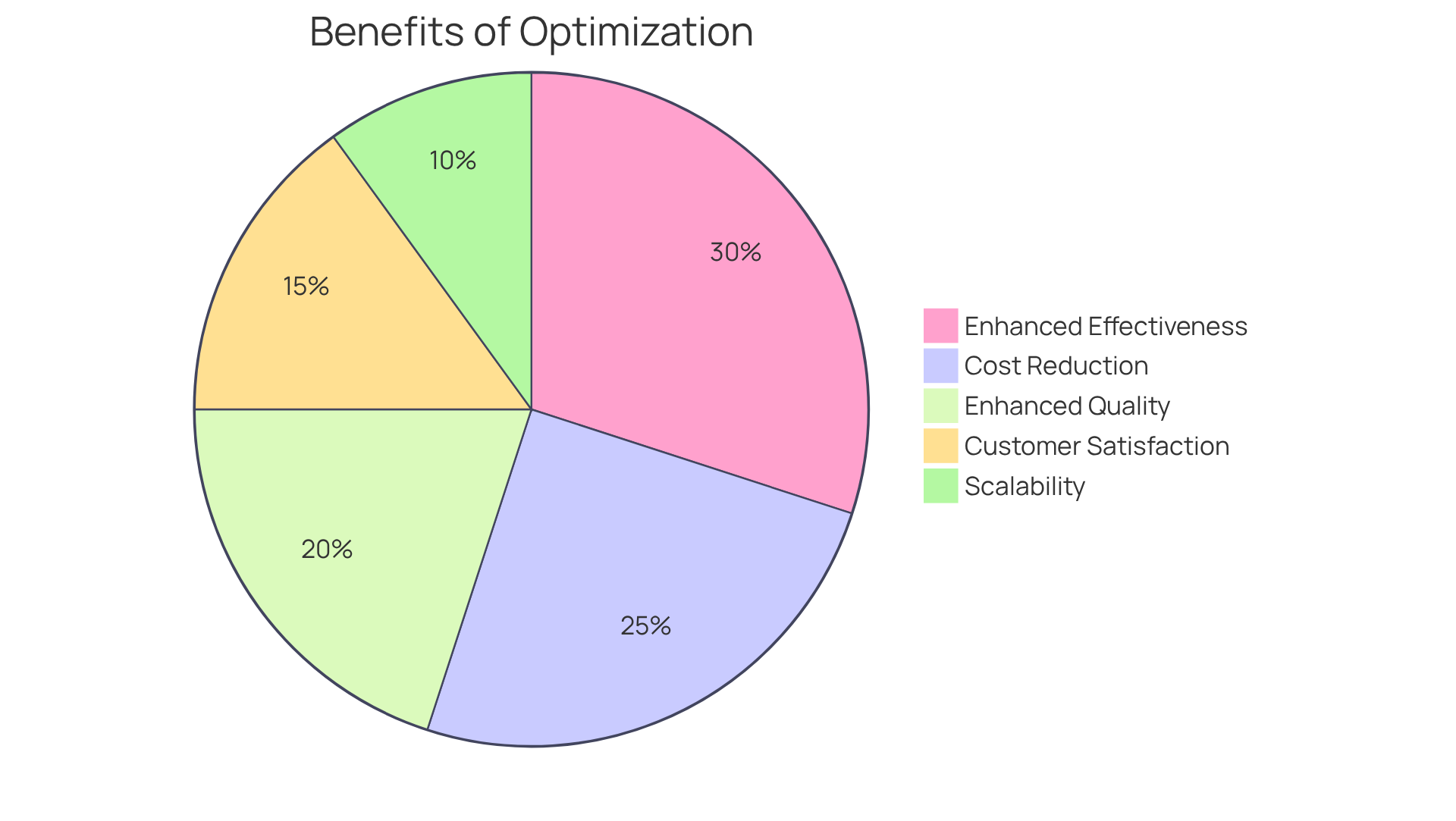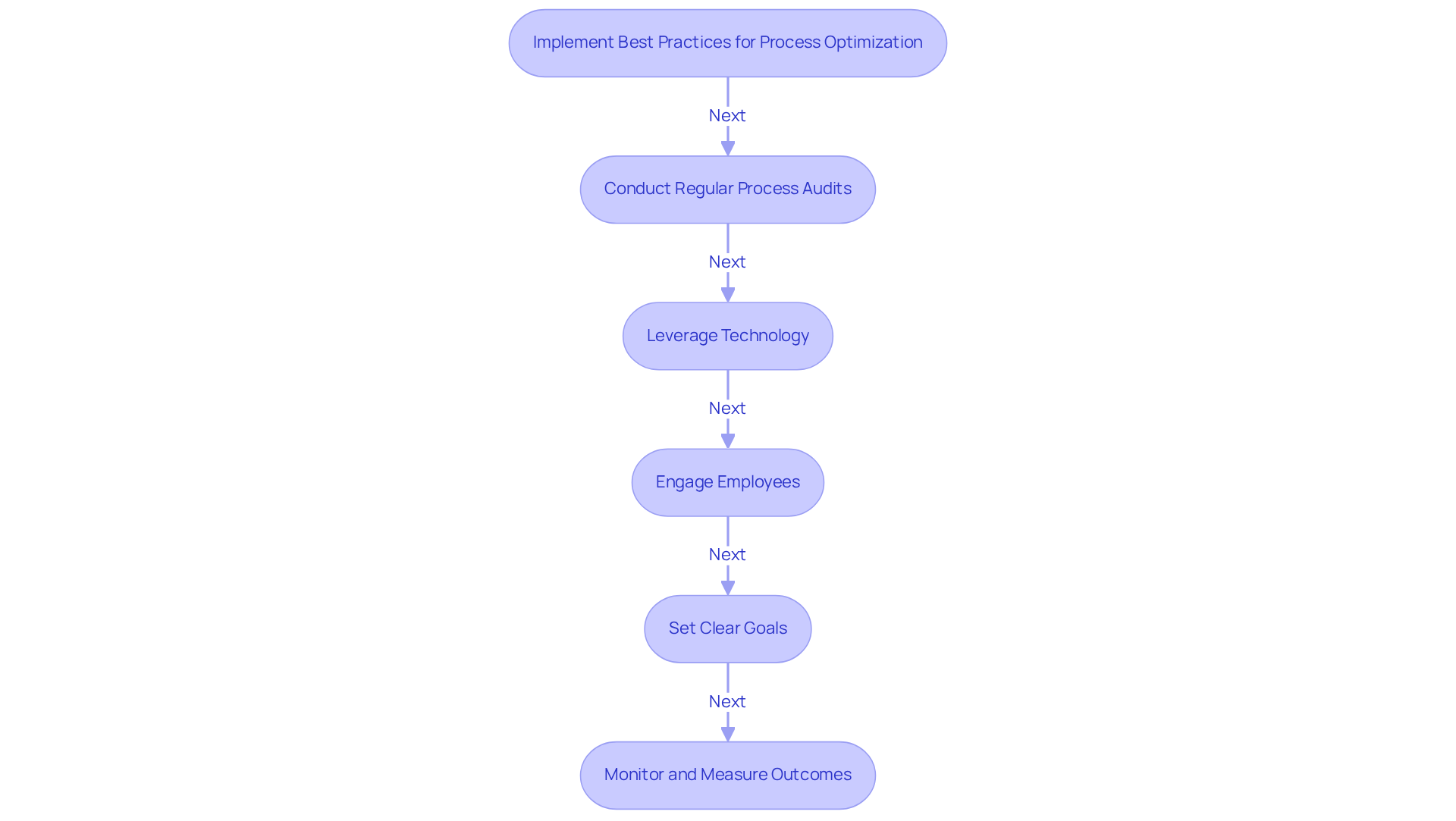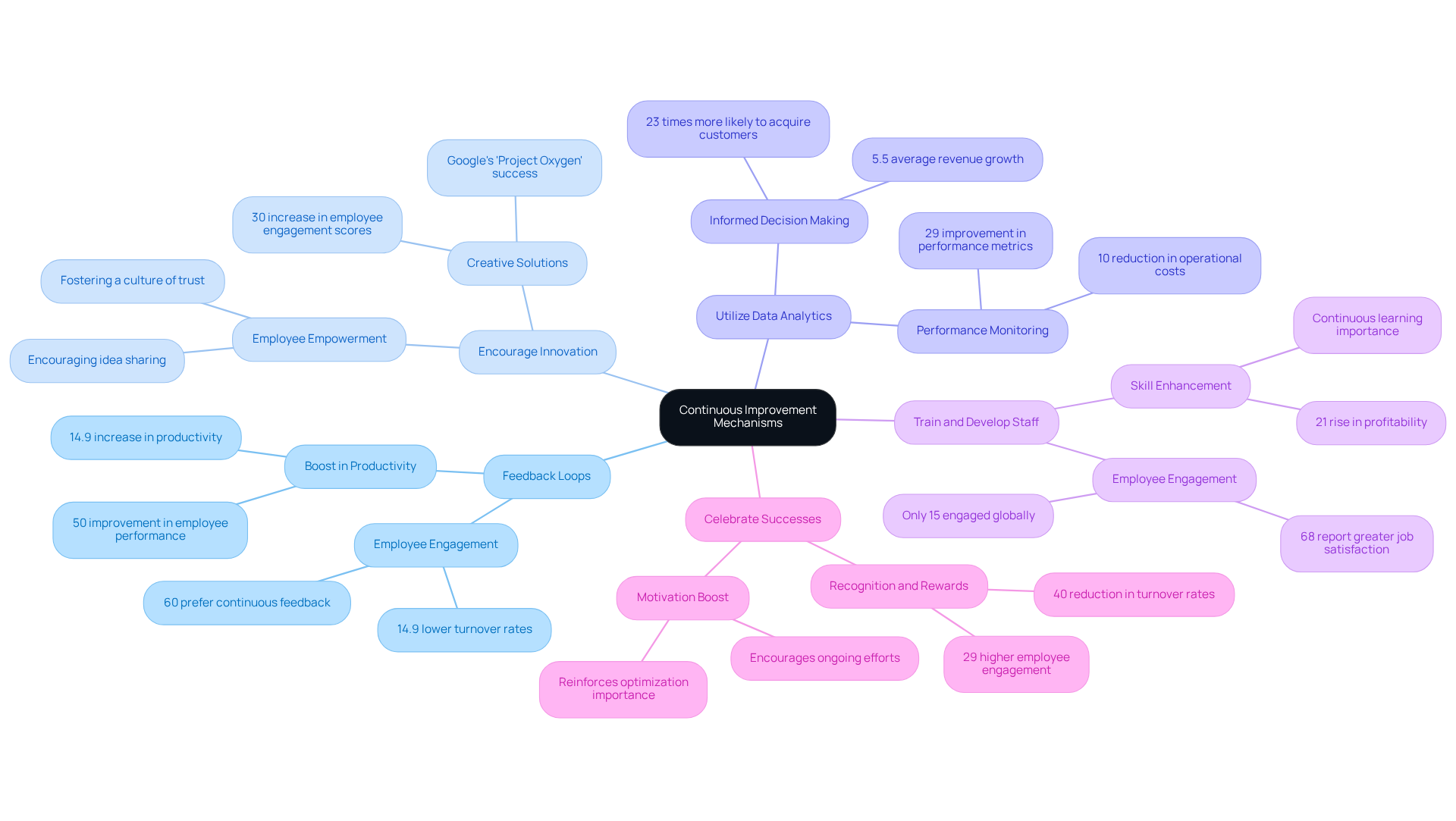
Overview
You might be wondering how optimizing your business operations can really make a difference. Well, let’s dive into it! By systematically identifying, mapping, and documenting workflows, you can significantly boost efficiency and cut costs. Imagine improving your effectiveness by up to 30%! That’s not just a number; it’s a game-changer.
Now, think about the redundancies that might be lurking in your processes. Eliminating those can lead to impressive cost reductions. Plus, faster service delivery means happier customers. Who doesn’t want that? So, as you explore these optimizations, keep in mind that they can lead to a more streamlined operation and a better experience for everyone involved.
Key Highlights:
- Business operations processes include all tasks companies perform to meet their goals, such as order fulfilment and customer support.
- Identifying key processes is essential; about 48% of businesses utilise a Business Workflow Management Programme.
- Mapping workflows can improve efficiency and reduce operational costs by up to 23%.
- Documenting processes increases project success rates by 70%, providing a reference for future optimizations.
- Optimising operations can enhance effectiveness by up to 30% and reduce costs by eliminating redundancies.
- Standardised methods lead to improved quality, with defect rates potentially reduced by 50%.
- Faster service can increase customer satisfaction ratings by 20%, fostering loyalty and repeat business.
- Regular process audits can decrease operational expenses by 20-30% and ensure compliance with regulations.
- Leveraging technology and automation can save organisations an average of $51,000 annually and reduce manual errors by up to 48%.
- Establishing feedback loops can boost productivity by 14.9% and staff performance by 50%.
- Investing in staff training and development can lead to a 21% rise in profitability.
Introduction
You might be wondering how optimizing business operations has shifted from being just a trend to a must-have for organizations wanting to thrive in today’s competitive landscape. As companies catch on to the importance of efficiency, it becomes clear that there are some serious benefits to reap—think enhanced effectiveness, cost savings, and happier customers. But here’s the kicker: the real challenge is figuring out how to define and implement these optimizations effectively. So, how can businesses not only pinpoint key processes but also keep them improving to meet those ever-changing demands?
Define Business Operations Processes
The business operations process encompasses all the tasks and activities that companies engage in to achieve their goals, whether that involves chatting with customers or managing the supply chain. So, how can organizations effectively define and optimize these processes? Let’s break it down into a few simple steps:
-
Identify Key Processes: First things first—make a list of all the critical operations in your company. Think order fulfillment, employee onboarding, and customer support. Did you know that about 48% of businesses have a Business Workflow Management Program? That’s a clear sign that more and more companies are recognizing the importance of identifying structured procedures.
-
Map Out Current Workflows: Next up, grab some flowcharts or task mapping tools to visualize how things are currently done. This will help you see the sequence of activities and the roles involved. There are plenty of success stories out there showing that by mapping workflows, companies can boost their efficiency and cut operational costs by up to 23%. Pretty impressive, right?
-
Document Each Step: Now, let’s talk documentation. It’s essential to create detailed notes for each procedure, covering inputs, outputs, and who’s responsible for what. This documentation is your go-to reference for future optimizations. With tools like SowFlow, teams can easily whip up user guides, making it a breeze to access the wisdom of their documentation with just a command. Plus, organizations that document their processes are likely to see a 70% increase in project success rates, according to industry insights. And with SowFlow, keeping that documentation fresh and relevant leads to real improvements in efficiency and productivity.
By following these steps, organizations can obtain a solid overview of their business operations process, which sets the stage for effective optimization and improved performance. As industry leaders often say, mapping workflows is key to ramping up operational efficiency and boosting customer satisfaction, which ultimately enhances business ROI. So, are you ready to dive in and make some changes?

Highlight Benefits of Optimization
Optimizing your business operations process can really change the game! Let’s dive into some of the awesome benefits that can elevate your organization:
-
Enhanced Effectiveness: You might be wondering how simplifying methods can help. Well, it reduces the time and resources needed to get things done, letting your team focus on what truly matters. Research shows that companies using optimization can see efficiency boosts of up to 30%! For instance, cutting batch sizes in half can also cut processing time down by half. As Anastasia Masadi, a Product Owner, puts it, "SowFlow has been a game changer in the way we document work and deliver to our clients. I do not have to take each screenshot separately, and do not even have to leave the browser while I am creating SOPs and training materials. SowFlow gave me time from my life back."
-
Cost Reduction: Now, who doesn’t want to save some cash? By spotting and removing redundancies within the business operations process, businesses can significantly lower their operational costs. This not only boosts profit margins but also frees up funds for growth initiatives. Remember what W. Edwards Deming said? '94% of issues in business are driven by systems.' So, improving the business operations process is essential for tackling those pesky inefficiencies.
-
Enhanced Quality: Let’s talk quality. Standardized methods from optimization lead to better quality control. This consistency means fewer mistakes, with studies showing companies can reduce defect rates by up to 50% by managing procedures efficiently. There are great case studies out there that showcase how organizations have improved quality through these optimizations.
-
Improved Customer Satisfaction: Who doesn’t love happy customers? Faster and more reliable service can significantly boost the customer experience, leading to loyalty and repeat business. Organizations that focus on enhancing efficiency often report a 20% increase in customer satisfaction ratings.
-
Scalability: Thinking about growth? Optimized procedures within the business operations process make it easier to expand operations without sacrificing quality or efficiency. Companies that embrace a scalable approach can grow their operations by 50% or more while keeping service standards high.
These benefits not only kickstart operational improvements but also set you up for long-term success in a competitive landscape. So, why not explore how these optimizations can work for you?

Implement Best Practices for Process Optimization
To effectively implement process optimization, you might be wondering what best practices to consider. Let’s dive into some ideas that can really make a difference:
-
Conduct Regular Process Audits: Periodically reviewing your processes is essential for spotting inefficiencies and areas for improvement. This proactive strategy can lead to a 20-30% decrease in operational expenses, plus it ensures you stay compliant with those ever-evolving regulations.
-
Leverage Technology: Have you thought about using automation tools? They can really streamline repetitive tasks and boost productivity. For example, SowFlow's documentation tool lets teams create user guides effortlessly. Instant updates keep your documentation relevant in today’s fast-paced business environment. Plus, automation can save organizations an average of $51,000 annually and cut down manual errors by up to 48%!
-
Engage Employees: It’s crucial to involve your team in the optimization process. Their insights can reveal current challenges and spark possible solutions, fostering a sense of ownership and accountability that drives practical advancements. With SowFlow, teams can access documentation instantly, which reduces the time spent hunting for information and boosts overall engagement.
-
Set Clear Goals: Defining specific, measurable objectives for your optimization efforts is vital. This clarity helps everyone stay focused and accountable, aligning their efforts with broader business goals like cutting costs and enhancing customer satisfaction.
-
Monitor and Measure Outcomes: After you implement changes, tracking performance metrics is essential to see how your optimization initiatives are doing. Keeping a close eye on things allows you to make informed tweaks, ensuring ongoing improvement and sustained operational excellence.
By embracing these best practices, you can foster a culture of constant advancement that enhances the business operations process and propels ongoing operational excellence. This ultimately leads to increased efficiency and effectiveness in your business operations process.

Establish Continuous Improvement Mechanisms
To cultivate a culture of continuous improvement, organizations should focus on a few key strategies that can really make a difference:
-
Implement Feedback Loops: You might be wondering how to get the most out of your team and customers. Establishing strong feedback mechanisms is a great start! By consistently evaluating input from both staff and customers, you can uncover crucial areas for improvement. Research shows that companies with effective feedback systems enjoy a 14.9% boost in productivity and a 4.6% increase in staff engagement. Plus, organizations that embrace regular feedback practices see a whopping 50% increase in staff performance. Clearly, feedback is essential for enhancing overall productivity!
-
Encourage Innovation: Now, let’s dive into creating a space where your team feels empowered to share ideas and try out new concepts. This culture of innovation can lead to creative solutions that significantly improve the business operations process. For example, a tech startup that introduced feedback loops and recognition programs saw a 30% increase in employee engagement scores within just a year. Similarly, Google’s 'Project Oxygen' initiative resulted in a 30% increase in retention rates after tackling turnover issues, proving that feedback mechanisms really do work wonders.
-
Utilize Data Analytics: Have you thought about how data analytics can help you monitor performance metrics and spot trends? This data-driven approach allows organizations to make informed decisions about improving their business operations process, leading to better outcomes. Companies that embrace ongoing improvement practices report an average revenue growth of 5.5% per year. Talk about a win-win!
-
Train and Develop Staff: Investing in comprehensive training programs is crucial for equipping your team with the skills they need to identify and implement improvements. Continuous learning is vital for maintaining excellence in the business operations process and adapting to ever-changing market demands. Organizations that prioritize personnel development see a 21% rise in profitability. And let’s face it, only 15% of workers globally are truly engaged in their tasks—this highlights the need for efficient feedback systems to boost engagement levels.
-
Celebrate Successes: Finally, don’t forget to recognize and reward your teams for their contributions to process improvements. Celebrating successes not only reinforces the importance of optimization but also motivates ongoing efforts. When accomplishments are acknowledged, you can see a 40% reduction in turnover rates as employees feel valued and engaged. It’s no surprise that organizations fostering such environments experience a 29% higher employee engagement level.
By establishing these mechanisms, organizations can create a resilient framework for continuous improvement, ensuring they stay competitive and efficient in an ever-evolving business landscape.

Conclusion
Optimizing your business operations processes is super important if you want to boost efficiency and drive growth. You might be wondering how to start—well, focusing on key areas like defining processes, mapping workflows, and documenting each step can really lay down a solid foundation for continuous improvement. This structured approach not only clears up roles and responsibilities but also helps you spot redundancies and streamline operations.
The perks of optimization are pretty significant! Think enhanced effectiveness, cost reduction, improved quality, happier customers, and the ability to scale. Engaging your employees in the process and leveraging technology can amplify these benefits even more, leading to a business environment that's agile and responsive. Plus, implementing best practices like regular audits, clear goal setting, and data analytics keeps you proactive in your optimization efforts.
Now, let’s dive into the heart of it: fostering a culture of continuous improvement is key for long-term success. By setting up feedback mechanisms, encouraging innovation, and celebrating achievements, you can keep that competitive edge in an ever-changing landscape. Embracing these strategies doesn’t just transform operations; it empowers your teams, boosts engagement, and enhances overall performance. So, why not take action and explore the wealth of opportunities that process optimization can offer? You’ve got this!
Frequently Asked Questions
What is the business operations process?
The business operations process includes all tasks and activities that companies engage in to achieve their goals, such as customer interactions and supply chain management.
What are the first steps to define and optimize business operations processes?
The first steps include identifying key processes, mapping out current workflows, and documenting each step of the procedures.
How can organizations identify key processes?
Organizations can identify key processes by making a list of critical operations, such as order fulfillment, employee onboarding, and customer support.
What is the benefit of mapping out current workflows?
Mapping out current workflows helps visualize the sequence of activities and roles involved, which can lead to increased efficiency and reduced operational costs, with some companies reporting up to a 23% cost reduction.
Why is documentation important in business operations processes?
Documentation is essential as it creates detailed notes for each procedure, covering inputs, outputs, and responsibilities, serving as a reference for future optimizations. Companies that document their processes can see a 70% increase in project success rates.
What tools can assist in documenting business processes?
Tools like SowFlow can help teams create user guides and maintain documentation, making it easier to access and update information.
What are the long-term benefits of optimizing business operations processes?
Optimizing business operations processes can lead to improved efficiency, increased productivity, enhanced customer satisfaction, and ultimately a better return on investment (ROI).
👍
What others are liking
5 Steps to outline your ideal documentation structure
5 MINS READ
Where to start the your journey of mapping out your ideal documentation structure, aligning it with the very heartbeat of your organization?
Defining a winning level of detail in your process
3 MINS READ
What is too much detail, and what is too little? This article described in that winning level detail about what detail is enough.





